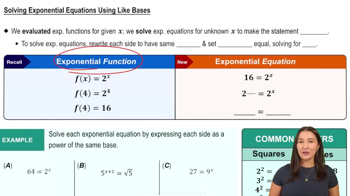Table of contents
- 0. Review of Algebra4h 16m
- 1. Equations & Inequalities3h 18m
- 2. Graphs of Equations43m
- 3. Functions2h 17m
- 4. Polynomial Functions1h 44m
- 5. Rational Functions1h 23m
- 6. Exponential & Logarithmic Functions2h 28m
- 7. Systems of Equations & Matrices4h 6m
- 8. Conic Sections2h 23m
- 9. Sequences, Series, & Induction1h 19m
- 10. Combinatorics & Probability1h 45m
6. Exponential & Logarithmic Functions
Solving Exponential and Logarithmic Equations
Problem 69a
Textbook Question
Solve each equation. Give solutions in exact form. See Examples 5–9. log x + log(x - 21) = log 100
 Verified step by step guidance
Verified step by step guidance1
Use the property of logarithms that states \( \log a + \log b = \log(ab) \) to combine the left side of the equation: \( \log x + \log(x - 21) = \log(x(x - 21)) \).
Now the equation becomes \( \log(x(x - 21)) = \log 100 \).
Since the logarithms on both sides of the equation are equal, set the arguments equal to each other: \( x(x - 21) = 100 \).
Expand the equation: \( x^2 - 21x = 100 \).
Rearrange the equation to form a quadratic equation: \( x^2 - 21x - 100 = 0 \).
Recommended similar problem, with video answer:
 Verified Solution
Verified SolutionThis video solution was recommended by our tutors as helpful for the problem above
Video duration:
5mPlay a video:
Was this helpful?
Key Concepts
Here are the essential concepts you must grasp in order to answer the question correctly.
Properties of Logarithms
Understanding the properties of logarithms is essential for solving logarithmic equations. Key properties include the product rule, which states that log(a) + log(b) = log(ab), and the power rule, which allows for the manipulation of exponents within logarithms. These properties help simplify equations and combine logarithmic terms effectively.
Recommended video:

Change of Base Property
Solving Logarithmic Equations
To solve logarithmic equations, one typically isolates the logarithmic expression and then exponentiates to eliminate the logarithm. This process often involves rewriting the equation in exponential form, which can lead to a polynomial equation that can be solved using algebraic methods. It's crucial to check for extraneous solutions that may arise from the logarithmic properties.
Recommended video:

Solving Logarithmic Equations
Domain Restrictions of Logarithmic Functions
Logarithmic functions have specific domain restrictions, as the argument of a logarithm must be positive. In the equation log(x) + log(x - 21) = log(100), both x and (x - 21) must be greater than zero. This means x must be greater than 21, which is an important consideration when determining valid solutions to the equation.
Recommended video:

Domain Restrictions of Composed Functions

 4:46m
4:46mWatch next
Master Solving Exponential Equations Using Like Bases with a bite sized video explanation from Callie
Start learningRelated Videos
Related Practice












